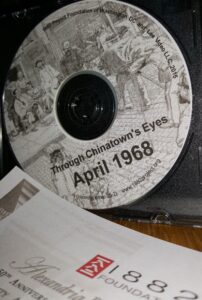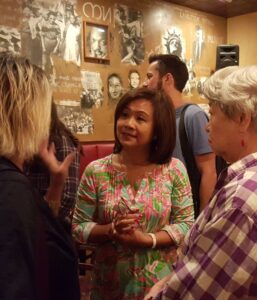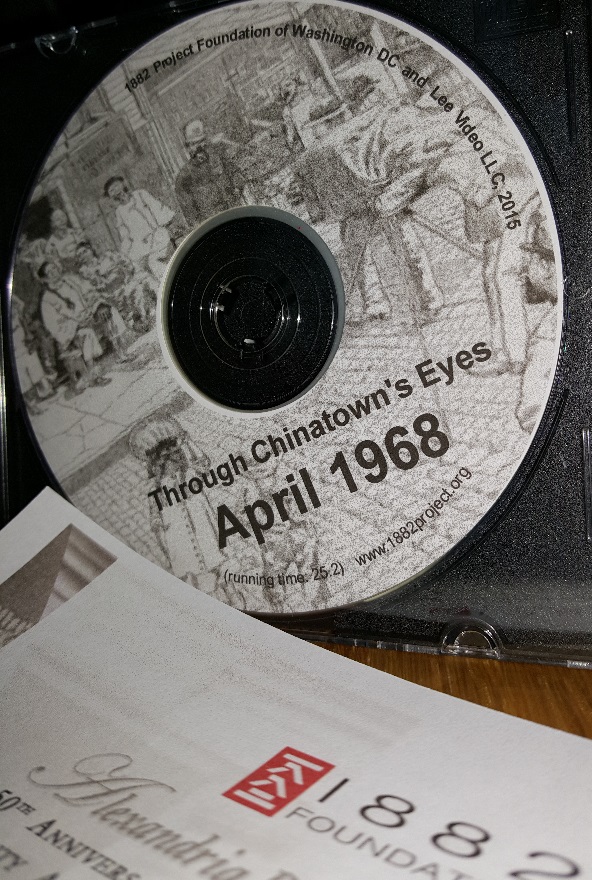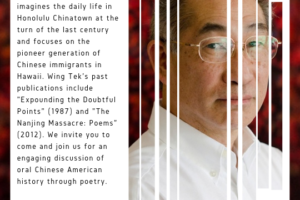 Through Chinatown’s Eyes First Episode: April 1968
Through Chinatown’s Eyes First Episode: April 1968
The first in a series of short documentaries, April 1968, examines the impact of the civil disturbances and street violence in DC on Chinatown after the assassination of Dr. Martin Luther King in April 1968. The story, from the perspective of people recalling events as school children and young adults in Chinatown, explores ideas about ethnic identity and race relationships. It tells how the street violence affected the growth of the neighborhood and its commercial development.
The film was produced by Penny Lee with Lisa Mao. It is a product of the 1882 Foundations’ DC Chinatown Oral History Project. The project seeks to record the oral histories of people who have a stake in preserving the history and heritage of DC Chinatown.
In collecting the oral histories (and images related to them), project directors wanted to preserve them as stories related to topics or themes or issues. Each story will be complete on its own, but together they will tell the history of DC Chinatown from its beginnings to today in a series of episodes that collectively we call “Through Chinatown’s Eyes.”
A grant from the DC Humanities Council determined the first episode. Under the “Who’s a Washingtonian Grant,” the 1882 Foundation leaders decided to group together memories and stories that dealt with the 1968 street violence and how ethnic neighborhoods interacted or related to one another.
The events of April 1968 were pivotal for Chinatown, as they were for the U Street neighborhood and the rest of urban DC. As such, April 1968 is a good episode to start the film series. It delineates a watershed between two time periods to help categorize our stories and conceptualize future episodes. The first period will collect stories generally about traditional perspectives and legacy Chinatown affiliations. The second period holds together stories that relate prominently to American acculturation and the fading of old organizations and livelihoods for a community moving decidedly to the suburbs, even as Chinatown still remains meaningful in a cultural sense.

What that meaning is, as an indicator of the future of Chinatown, becomes a key question to explore. The question and the effort to articulate answers becomes the purpose of the effort to gather and preserve the stories.
Future episodes of the Through Chinatown’s Eyes series will either go one direction to uncover older history and traditions. These include episodes about family associations, reasons to settle in DC, original function of Chinatown, daily life and society including the direct consequences of the Chinese exclusion laws and the immediate impact of WWII. Episodes can go the other direction to examine topics about activities related to American civil rights and participation in mainstream political actions, the evolution of Chinatown businesses, changing youth activities and the gentrification of DC Chinatown.
A list of potential episodes is added below. We welcome suggestions for others episodes. Each episode will run no longer than 30 minutes. Each will have a study guide similar to the one developed for April 1968. The study guide is important because the mission of 1882 Foundation and this film series is not just to collect and re-tell entertaining stories. Fundamentally, it is to educate the public about the history of Chinese in America and its continuing and future significance to all Americans.
Suggested episodes:
1. Gold Mountain Hopes — Why Chinese came to DC Part I: Patterns and routes from Canton, the Angel Island legacy. Why DC?
- The Promise – About the enabling and protective roles of family associations and traditions seen through the “promise” of care even after death illustrated by Qing Ming rites surrounding DC and Range 99 at the Congressional Cemetery.
- Safe Harbors — Why Chinese came to DC Part II: Patterns and routes from North China and Taiwan. The legacy of Yung Wing, the Northeast Chinese university movement, Two Chinas, and Tian An Men, students and professional elites. “the legal 105.”
- Community and Youth – Becoming American while holding onto Chinese Community through Church and Youth Club.
- Pennies for China and Fighting for America — Choices and Commitments, traditionalism and nationalism to China/patriotism to America.
- April 1968 — Choosing to Stay and Defining identity – Done.
- The Bean Sprout King – Thriving in Chinatown, building prosperity and family life, living the Dream. Teen dances, radio shows, football cars and beauty queens.
- Movable Chinatowns – Pull Factors: Why Chinese leave DC Part I: Opportunities pull away. Capabilities and skills no longer restricted to Chinatown. Once out, why return?
- Gentrification – Push Factors: Why Chinese leave DC Part II: Increasing Costs and Rich Real Estates push Chinese out. Pan-Asian fusion and the rise of the Young Professional
- Cultural Touchstone — Lion Dancing, 9-man Volley Ball and Talk Story
- Creating a Cultural Destination – Relevancy. Preserving story sites as well as physical sites. Chinatown as a Museum. What lies ahead for Chinatown in DC and other Chinatowns. Pan-Asian-ism as “cultural gentrification.”
In addition to funding provided by the DC Humanities Council, April 1968 received financial backing from the Chinese American Citizens Alliance, the Sino American Cultural Society and OCA. The 1882 Foundation is a non-profit 501(c)3 organization.


